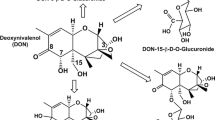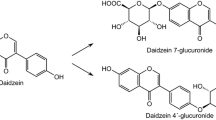ABSTRACT
Purposes
Glucuronidation via UDP-glucuronosyltransferases (or UGTs) is a major metabolic pathway. The purposes of this study are to determine the UGT-isoform-specific metabolic fingerprint (or GSMF) of wogonin and oroxylin A, and to use isoform-specific metabolism rates and kinetics to determine and describe their glucuronidation behaviors in tissue microsomes.
Methods
In vitro glucuronidation rates and profiles were measured using expressed UGTs and human intestinal and liver microsomes.
Results
GSMF experiments indicated that both flavonoids were metabolized mainly by UGT1As, with major contributions from UGT1A3 and UGT1A7-1A10. Isoform-specific metabolism showed that kinetic profiles obtained using expressed UGT1A3 and UGT1A7-1A10 could fit to known kinetic models. Glucuronidation of both flavonoids in human intestinal and liver microsomes followed simple Michaelis-Menten kinetics. A comparison of the kinetic parameters and profiles suggests that UGT1A9 is likely the main isoform responsible for liver metabolism. In contrast, a combination of UGT1As with a major contribution from UGT1A10 contributed to their intestinal metabolism. Correlation studies clearly showed that UGT isoform-specific metabolism could describe their metabolism rates and profiles in human liver and intestinal microsomes.
Conclusion
GSMF and isoform-specific metabolism profiles can determine and describe glucuronidation rates and profiles in human tissue microsomes.









Similar content being viewed by others
Abbreviations
- AIC:
-
Akaike’s information criterion
- DHF:
-
di-hydroxyl flavone
- DHFG:
-
di-hydroxyl flavone glucuronide
- GSMF:
-
UGT-isoform specific metabolic fingerprint
- HIM:
-
human intestinal microsomes
- HLM:
-
human liver microsomes
- MAICE:
-
minimum AIC estimation
- UDPGA:
-
Uridine diphosphate glucuronic acid
- UGTs:
-
UDP-glucuronosyltransferases
REFERENCES
Kiang TK, Ensom MH, Chang TK. UDP-glucuronosyltransferases and clinical drug-drug interactions. Pharmacol Ther. 2005;106:97–132.
Ando Y, Hasegawa Y. Clinical pharmacogenetics of irinotecan (CPT-11). Drug Metab Rev. 2005;37:565–74.
Tang L, Singh R, Liu Z, Hu M. Structure and concentration changes affect characterization of UGT isoform-specific metabolism of isoflavones. Mol Pharm. 2009;6:1466–82.
Wang SW, Chen J, Jia X, Tam VH, Hu M. Disposition of flavonoids via enteric recycling: structural effects and lack of correlations between in vitro and in situ metabolic properties. Drug Metab Dispos. 2006;34:1837–48.
Baumann S, Fas SC, Giaisi M, Muller WW, Merling A, Gulow K et al. Wogonin preferentially kills malignant lymphocytes and suppresses T-cell tumor growth by inducing PLCgamma1- and Ca2+-dependent apoptosis. Blood. 2008;111:2354–63.
Chung H, Jung YM, Shin DH, Lee JY, Oh MY, Kim HJ et al. Anticancer effects of wogonin in both estrogen receptor-positive and -negative human breast cancer cell lines in vitro and in nude mice xenografts. Int J Cancer. 2008;122:816–22.
Hu Y, Yang Y, You QD, Liu W, Gu HY, Zhao L et al. Oroxylin A induced apoptosis of human hepatocellular carcinoma cell line HepG2 was involved in its antitumor activity. Biochem Biophys Res Commun. 2006;351:521–7.
Li HN, Nie FF, Liu W, Dai QS, Lu N, Qi Q et al. Apoptosis induction of oroxylin A in human cervical cancer HeLa cell line in vitro and in vivo. Toxicology. 2009;257:80–5.
Sun Y, Lu N, Ling Y, Gao Y, Chen Y, Wang L et al. Oroxylin A suppresses invasion through down-regulating the expression of matrix metalloproteinase-2/9 in MDA-MB-435 human breast cancer cells. Eur J Pharmacol. 2009;603:22–8.
Peng J, Qi Q, You Q, Hu R, Liu W, Feng F et al. Subchronic toxicity and plasma pharmacokinetic studies on wogonin, a natural flavonoid, in Beagle dogs. J Ethnopharmacol. 2009;124:257–62.
Yano H, Mizoguchi A, Fukuda K, Haramaki M, Ogasawara S, Momosaki S et al. The herbal medicine sho-saiko-to inhibits proliferation of cancer cell lines by inducing apoptosis and arrest at the G0/G1 phase. Cancer Res. 1994;54:448–54.
Bonham M, Posakony J, Coleman I, Montgomery B, Simon J, Nelson PS. Characterization of chemical constituents in Scutellaria baicalensis with antiandrogenic and growth-inhibitory activities toward prostate carcinoma. Clin Cancer Res. 2005;11:3905–14.
Zhang DY, Wu J, Ye F, Xue L, Jiang S, Yi J et al. Inhibition of cancer cell proliferation and prostaglandin E2 synthesis by Scutellaria baicalensis. Cancer Res. 2003;63:4037–43.
Yu J, Liu H, Lei J, Tan W, Hu X, Zou G. Antitumor activity of chloroform fraction of Scutellaria barbata and its active constituents. Phytother Res. 2007;21:817–22.
Li-Weber M. New therapeutic aspects of flavones: the anticancer properties of Scutellaria and its main active constituents Wogonin, Baicalein and Baicalin. Cancer Treat Rev. 2009;35:57–68.
Mu R, Qi Q, Gu H, Wang J, Yang Y, Rong J, et al. Involvement of p53 in oroxylin A-induced apoptosis in cancer cells. Mol Carcinog, 2009.
Commentary MHu. bioavailability of flavonoids and polyphenols: call to arms. Mol Pharm. 2007;4:803–06.
Tsai TH, Chou CJ, Tsai TR, Chen CF. Determination of wogonin in rat plasma by liquid chromatography and its pharmacokinetic application. Planta Med. 1996;62:263–6.
Kim YH, Jeong DW, Kim YC, Sohn DH, Park ES, Lee HS. Pharmacokinetics of baicalein, baicalin and wogonin after oral administration of a standardized extract of Scutellaria baicalensis, PF-2405 in rats. Arch Pharm Res. 2007;30:260–5.
Lai MY, Hsiu SL, Chen CC, Hou YC, Chao PD. Urinary pharmacokinetics of baicalein, wogonin and their glycosides after oral administration of Scutellariae Radix in humans. Biol Pharm Bull. 2003;26:79–83.
Ueng YF, Shyu CC, Lin YL, Park SS, Liao JF, Chen CF. Effects of baicalein and wogonin on drug-metabolizing enzymes in C57BL/6J mice. Life Sci. 2000;67:2189–200.
Jeong EJ, Liu X, Jia X, Chen J, Hu M. Coupling of conjugating enzymes and efflux transporters: impact on bioavailability and drug interactions. Curr Drug Metab. 2005;6:455–68.
Ohno S, Nakajin S. Determination of mRNA expression of human UDP-glucuronosyltransferases and application for localization in various human tissues by real-time reverse transcriptase-polymerase chain reaction. Drug Metab Dispos. 2009;37:32–40.
Joseph TB, Wang SW, Liu X, Kulkarni KH, Wang J, Xu H et al. Disposition of flavonoids via enteric recycling: enzyme stability affects characterization of prunetin glucuronidation across species, organs, and UGT isoforms. Mol Pharm. 2007;4:883–94.
Liu X, Tam VH, Hu M. Disposition of flavonoids via enteric recycling: determination of the UDP-glucuronosyltransferase isoforms responsible for the metabolism of flavonoids in intact Caco-2 TC7 cells using siRNA. Mol Pharm. 2007;4:873–82.
Zhang L, Lin G, Zuo Z. Position preference on glucuronidation of mono-hydroxylflavones in human intestine. Life Sci. 2006;78:2772–80.
Houston JB, Kenworthy KE. In vitro-in vivo scaling of CYP kinetic data not consistent with the classical Michaelis-Menten model. Drug Metab Dispos. 2000;28:246–54.
Hutzler JM, Tracy TS. Atypical kinetic profiles in drug metabolism reactions. Drug Metab Dispos. 2002;30:355–62.
D’Argenio DZ, ADAPT SA, User’s Guide II. Pharmacokinetic Pharmacodynamic Systems Analysis Software. Los Angeles: University of Southern California; 1997.
Yamaoka K, Nakagawa T, Uno T. Application of Akaike’s information criterion (AIC) in the evaluation of linear pharmacokinetic equations. J Pharmacokinet Biopharm. 1978;6:165–75.
Akaike H. Information theory and an extension of the maximum likelihood principle. In: Petrov BN, Csaki F, editors. 2nd International Symposium on Information Theory. Budapest: Akademia Kiado; 1973. p. 267–81.
Chen X, Wang H, Du Y, Zhong D. Quantitation of the flavonoid wogonin and its major metabolite wogonin-7 beta-D-glucuronide in rat plasma by liquid chromatography-tandem mass spectrometry. J Chromatogr B Analyt Technol Biomed Life Sci. 2002;775:169–78.
Mackenzie PI, Bock KW, Burchell B, Guillemette C, Ikushiro S, Iyanagi T et al. Nomenclature update for the mammalian UDP glycosyltransferase (UGT) gene superfamily. Pharmacogenet Genomics. 2005;15:677–85.
Gibson CR, Bergman A, Lu P, Kesisoglou F, Denney WS, Mulrooney E. Prediction of Phase I single-dose pharmacokinetics using recombinant cytochromes P450 and physiologically based modelling. Xenobiotica. 2009;39:637–48.
Mackenzie PI, Rogers A, Treloar J, Jorgensen BR, Miners JO, Meech R. Identification of UDP glycosyltransferase 3A1 as a UDP N-acetylglucosaminyltransferase. J Biol Chem, 2008.
Carlini LE, Meropol NJ, Bever J, Andria ML, Hill T, Gold P et al. UGT1A7 and UGT1A9 polymorphisms predict response and toxicity in colorectal cancer patients treated with capecitabine/irinotecan. Clin Cancer Res. 2005;11:1226–36.
ACKNOWLEDGEMENTS
This work was mainly supported by the Ministry of Science and Technology of the People’s Republic of China Grants 2006BAT11B08-4, and the Grant of Science and Technology of Guangzhou 2006Z1-E6021, both to ZL. MH was also supported by NIH GM070737. The authors would like to thank Dr. Vincent Tam of University of Houston College of Pharmacy for his help in rendering the program to analyze the kinetics of glucuronidation by UGT 1A3. The authors would like to acknowledge Ms. Ling Ye for her technical assistance in the measurement of metabolites using LC-MS/MS. Additional technical assistance by Ms. Jie Zhao in the determination of conversion factor is also acknowledged here.
Author information
Authors and Affiliations
Corresponding authors
Rights and permissions
About this article
Cite this article
Zhou, Q., Zheng, Z., Xia, B. et al. Use of Isoform-Specific UGT Metabolism to Determine and Describe Rates and Profiles of Glucuronidation of Wogonin and Oroxylin A by Human Liver and Intestinal Microsomes. Pharm Res 27, 1568–1583 (2010). https://doi.org/10.1007/s11095-010-0148-0
Received:
Accepted:
Published:
Issue Date:
DOI: https://doi.org/10.1007/s11095-010-0148-0




